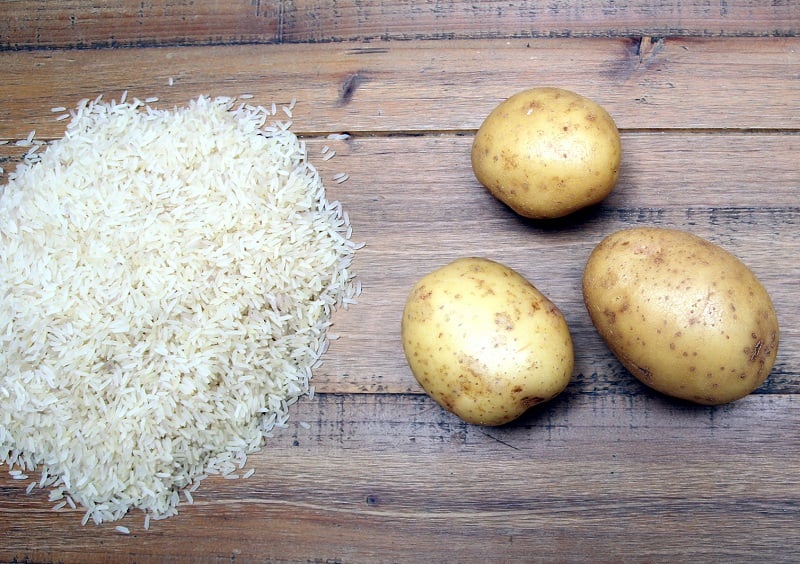Rice or Potatoes: Which Side is Healthier For You?

If you come to dinner at my house, you will often find a standard meal consisting of a protein, a vegetable, and a starchy carbohydrate consisting of something like rice or potatoes. *Gasp!* I know, right? We still eat pasta, rice or potatoes at my house, and sometimes we even have pizza, and we do so without batting an eyelash. And you know what? We have lived to talk about it.
You may have expected me to say neither rice nor potatoes and start talking about cauliflower instead. Yet I haven’t replaced all carbs with cauliflower, although I have quite a few recipes up my sleeve for making delicious cauliflower dishes that rival some of my other white veggies. But that doesn’t mean I don’t balance this out with other healthy, smart choices.
Balance and moderation is the name of the game, folks.
Rice or Potatoes: What’s the Healthier Side?
Many of us are so hung up on avoiding carbohydrates that we have forgotten there are plenty of nutrients that can be found in rice or potatoes.
Nutrients found in white rice include:
- Carbohydrates
- Protein
- Fiber (though much less than potatoes)
- B vitamins and vitamin E in very small quantities
- Calcium, manganese, magnesium, selenium, phosphorous, and iron in very small quantities
- Plus, it’s fairly low calorie with just 200 calories in a cup of cooked rice
Nutrients found in potatoes:
- Carbohydrates
- Protein
- Fiber—much more than rice, particularly if eaten with its skin
- B vitamins and vitamin C
- Magnesium, iron, and potassium (more than a banana)
- And it’s also fairly low calorie with 200 calories in four small boiled potatoes
Carbs:
Based on ½ cup serving of each, there are 23 grams of total carbs in white or brown rice vs 30 grams of total carbs in a potato and 12 grams of total carbs in a sweet potato.
Sugar:
One serving of potatoes contains two grams of sugar, which is the same as one serving of rice. Interestingly, though, a serving of sweet potato has up to seven grams of sugar, which is higher than both white rice and white potato.
Fiber:
Potatoes have three grams in one serving of white potato with less than one in a serving of white rice. Something to keep in mind, though, is that you lose about half the fiber from a potato if you don’t eat the skin.
Glycemic Index:
Now to get into the nitty gritty, let’s discuss the glycemic index (GI). This is a handy tool which rates foods on a scale of zero to 100, where 100 equals the large spike caused by glucose. Any score of that’s 70 or better is considered high glycemic, significantly raising blood sugar. Depending on the variety of rice you choose, the GI can range from 48 to 92 with the average for most types of rice being around 64, which is in the medium range. Sweet potatoes score a 63, and white boiled potatoes can go as high as 78.
Levels of blood sugar go up after you eat carbs, then they drop below normal as insulin rushes in to get excess sugar out of the bloodstream, until blood sugar settles back to normal. When blood sugar drops, you start to feel hungry. It your blood sugar gets too high, you’re more likely to shuttle the excess sugar into fat stores.
So, by using the glycemic index, you can see how both rice or potatoes will affect your blood sugar. Yet it’s also important to remember that you likely won’t eat your rice or potatoes alone. They’re more often included in part of a meal, and if you combine your carbs with protein and fat, you can help manage your blood sugar response.
Resistant Starch:
Now to take things one step further, there is something called resistant starch. Resistant starch changes the structure of starches when the food ingredient is cooked and then cooled. And it’s been shown to increase metabolic rate, reduce the caloric density, decrease the glycemic response, improve insulin response and sensitivity, reduce hunger, and more. Plus, it’s a prebiotic fiber that feeds the good bacteria in the digestive tract. (In other words, resistant starch is seriously good for our bodies!) By letting rice and potatoes cool before eating them, you gain more resistant starch and fewer net carbs.
Rice or Potatoes: Coach Cristina’s Verdict
For me personally, if given the choice between rice or potatoes, 9 times out of 10, I would go with potatoes simply because they are more versatile and can be made a million different ways. There isn’t much you can do with rice without changing up the herbs and spices, but you can slice, dice, bake, sauté, fry, mash, and so much more with a potato.
And as mentioned above, you can also make them healthier by eating them chilled, which makes for an excellent potato salad, which is yet another way potatoes sway the vote for me. But at the end of the day, either rice or potatoes can be part of a healthy meal.






